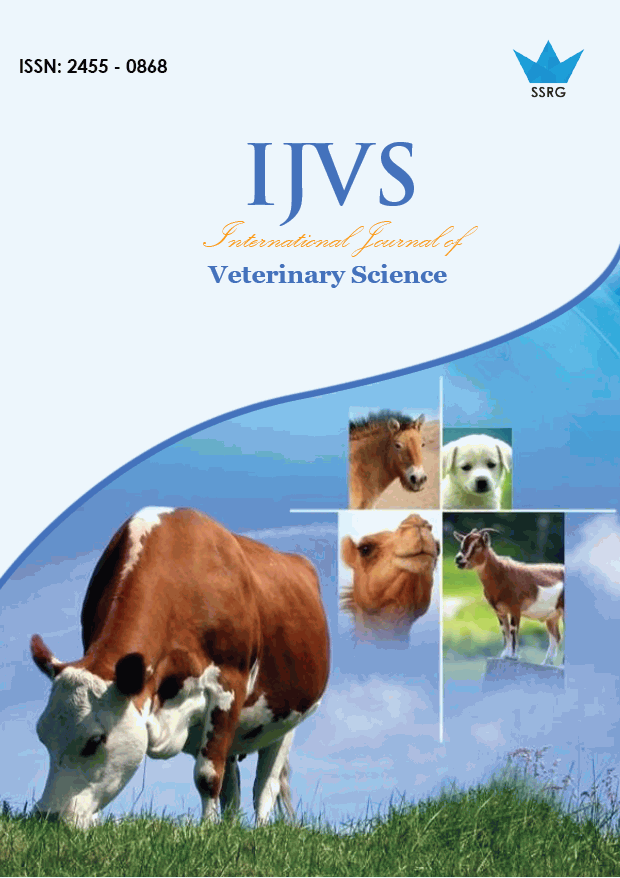Pattern of Blood Vessels Development at First Seven Days of Incubation of the Wild Helmeted Guinea Fowl (Numida meleagris galeata). Gross Approach

| International Journal of Veterinary Science |
| © 2020 by SSRG - IJVS Journal |
| Volume 6 Issue 2 |
| Year of Publication : 2020 |
| Authors : N Wanmi, OM Samuel, N Plang, BE OKE |
How to Cite?
N Wanmi, OM Samuel, N Plang, BE OKE, "Pattern of Blood Vessels Development at First Seven Days of Incubation of the Wild Helmeted Guinea Fowl (Numida meleagris galeata). Gross Approach," SSRG International Journal of Veterinary Science, vol. 6, no. 2, pp. 1-5, 2020. Crossref, https://doi.org/10.14445/24550868/IJVS-V6I2P101
Abstract:
The wild helmeted guinea fowl has in recent time been used for research in the field of anatomy because of its peculiarity from other domesticated species of avian. Eggs of the wild helmeted guinea fowl are considered to be nutritious and has been used for medicinal purposes in some rural settlements in Nigeria. Eggs of the wild helmeted guinea fowl were purchased from hunters and taken to the National Veterinary Research Institution (NVRI) for incubation. Immediately fresh eggs were purchased, it was kindle using high powered light because of its thick egg shell and only eggs which have not started developing will be incubated and that marks the first day of incubation. On day 3 of incubation, large patches of appears redden on the surface of the egg yolk. These congested sites, develop around portion were future embryo will formed. Blood vessel were first, observed on day 4 of incubation and as days on, as embryo increases in size, blood vessels increase as well. The point of embryo implantation is evident first; by formation of congested areas and most importantly, a single zone of circular red rim. This mark the point of implantation. Blood vessels of the wild helmeted guinea fowl develops from the surface of the egg yolk, which appears initially as small strips of line. Blood vessels connects to the site of embryo implantation on day 3 of incubation. Blood vessel is the first structure to be form prior to the manifestation of the embryo.
Keywords:
Days, Ontogeny, Seven, Vessel
References:
[1] Ayeni, J. S. O . “The biology and utilization of the helmeted guinea fowl (Numida meleagris galeata, Pallas). Ph.D. Thesis”. University of Ibadan, Ibadan, Nigeria. Unpublished. 1980.
[2] Ayeni, J. S. O., Olow0-okorun, M. O., Tom, A. A. “The biology and utilization of helmeted guinea fowl (Numida meleagris galeata pallas) in Nigeria”. III. Gizzard weight and content. African journal of ecology, 21(1): 11-18, 1983.
[3] Ayorinde, K. L. “Characteristics and genetic improvement of the grey breasted helmeted guinea fowl”, Numida meleagris galeata pallas in for growth and meat production. Ph.D. Thesis. University of Ibadan, Nigeria. Unpublished, 1987.
[4] Smith, J., Guinea fowl. Diversification Data Base. Scottish Agricultural College. Available in:<http://www.sac.ac.uk/management/external/dive rsification/tableofcontents, Date accessed: 24th November, 2001. Pp. 3. 1920.
[5] Ligomela, B. “Population growth compatible with sustainable development. The Zambezi Newsletter. Musokotwane Environment Resource” Center for Southern Africa. Pp. 3. 2000.
[6] Cactus, R. Guinea fowl assortment. Available in:<htttp://www.cactusranchgamebirds.com/guineaf.html. Accessed: 10th December, 2001.
[7] Fajemilehin, S.O.K. “Morphostructural characteristics of three varieties of grey breasted helmeted guinea fowl in Nigeria”. International Journal of Morphology, 28(2): 557-562, 2010.
[8] Folkman, J. “Towards an understanding an angiogenesis: search and discovery perspective in biology and medicine”, Pubmed 29:10, 1985.
[9] Risau, W., and Lammon, V., “Changes in the vascular extracellular matrix during embryonic vasculogenesis and angiogenesis”. Dev. Biology 125; 144, 1988.
[10] Sabin, F, R., “Studies on the origin of the blood vessels and of red blood corpuscles and seen the living blastoderm of chicks during the second day incubation”, in contribution to embryology, Vol. 9, Carnegie Institution Washington, PP. 214-262, 1920.
[11] Pardanaud, L., Altman, C., Kitos, P., Dieterlen-Lievre, F., and Buck, C. A. “Vasculogenesis in the early quill blastodisc as studied with a monoclonal cells,” Development, 100:339, 1987.
[12] Wanmi, N., Onyeanusi, I. B., Nzalak, J. O., Aluwong, T., “Structural Organization of the Optic Lobe of Grey Breasted Helmeted Guinea Fowl (*Numida Meleagris Galeata*) at Pre-Hatch Study journal of biology and life sciences”, Vol. 7, No.2. 2016.
[13] Salami, S.O., “Studies on the onset of osteogenesis in grey breasted guinea fowl “(Numida Meleagris galeata), Ph. D. Thesis Unpublished. Ahmadu Bello University, Zaria, Nigeria. 2009.
[14] Gosomji, I. “Morphogenesis of the gastrointestinal tract of the helmeted guinea fowl” (Numida meleagris galeata).M.Sc Thesis. Ahmadu Bello University, Zaria. Unpublished, 2014.
[15] Serdar, A., and Emrah, S., “The development of chicken cerebellar cortex and the determination of AgNOR activity of the Purkinje cell nuclei”, Belg. Journal of Zoology, 140 (2): 216-224, 2010.
[16] Needham J. A., “History of Embryology”. Cambridge University Press; Cambridge, UK: 1959.
[17] Chapman, S. C., Collignon, J., Schoenwolf, G. C., Lumsden, A. “Improved method for chick whole-embryo culture using a filter paper carrier.” Dev. Dyn. 220:284–289, 2001.
[18] Naber, F. C., and Squires, M. W., “Early detection of the presence of a vitamin premix in layer diets by egg albumen riboflavin analysis”. Poultry Science, 72: 1989-1993, 1993.
[19] Belliars, R., and Osmond, M. “The Atlas of Chick Development”, 2nd Edition (Elsevier academic press, Oxford), 2005.
[20] Eyal–Giladi, H., and Kochav, S. “From Cleavage to premature Streak Formation, a complementary normal table and a new Look of the first Stage of the development of the chick. I”. General Morphology Dev. Bio. 49: 321-337, 1975.

 10.14445/24550868/IJVS-V6I2P101
10.14445/24550868/IJVS-V6I2P101